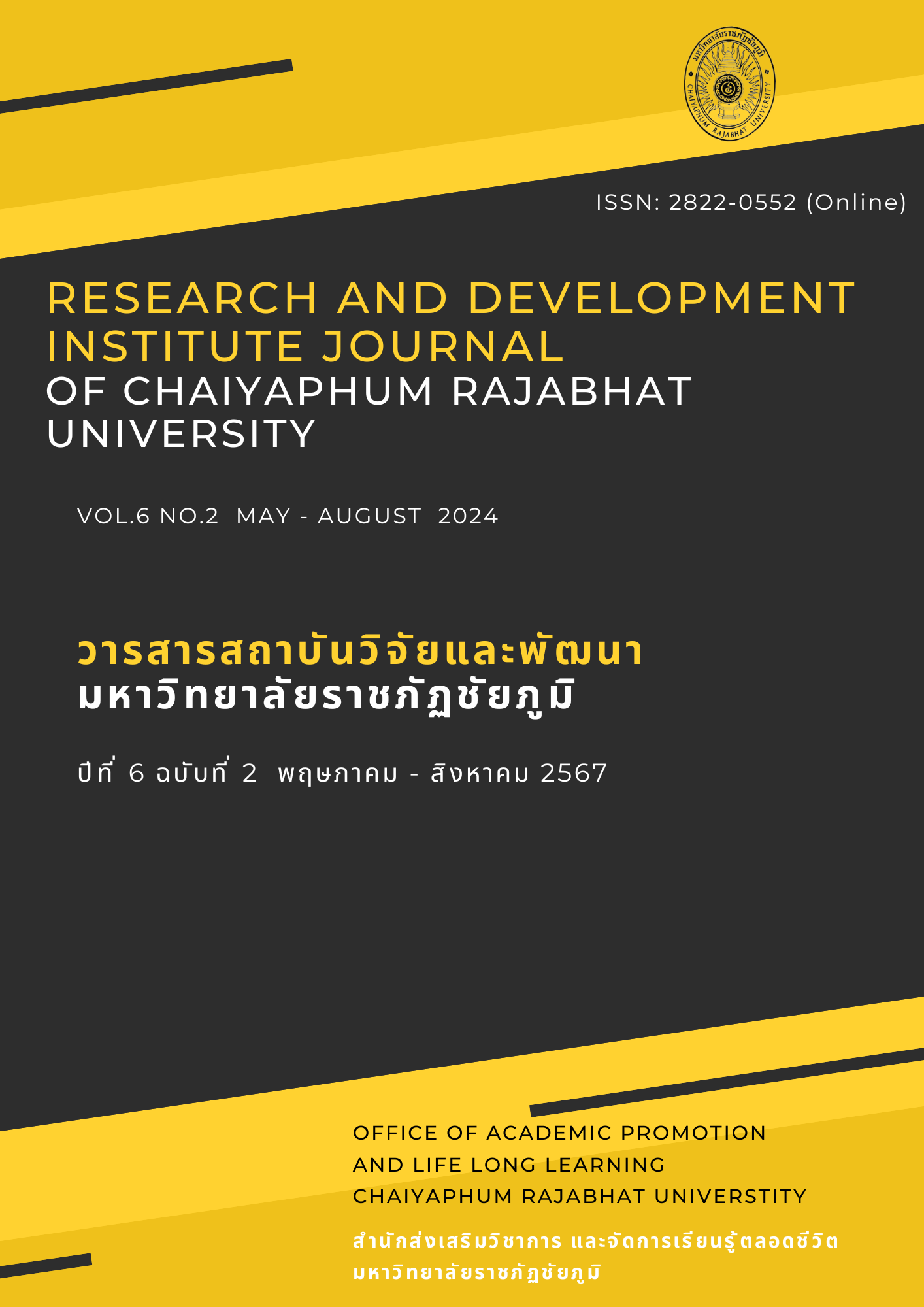NEEDS FOR PROFESSIONAL LEARNING COMMUNITY PROMOTION OF SMALL-SIZED SCHOOLS UNDER KALASIN PRIMARY EDUCATIONAL SERVICE AREA OFFICE 2
Main Article Content
Abstract
The purposes of this research were 1) to study the current situation, the desirable conditions and needs, and 2) to study guidelines for professional learning community promotion of small-sized schools under Kalasin Primary Educational Service Area Office 2. The sample group's size used in this research was determined from Taro Yamane's formula at 0.05 level of sampling error classified by position using simple random sampling method. The sample group consisted of 34 administrators and 256 teachers, with the total number of 290 people. The instrument used to collect data was a 5-level rating scale questionnaire with reliability at 0.97. The statistics used for analyzing data comprised percentage, frequency, mean, standard deviation and PNI Modified index.
The results of the research found that:
- The current situation, the desirable conditions, and needs for professional learning community promotion of small-sized schools under Kalasin Primary Educational Service Area Office 2 were found that the current situation was rated at a high level, the desirable conditions were rated at the highest level, and needs for professional learning community promotion of small-sized schools, arranged in order of the highest level of needs, were as follows: 1) the aspect of being caring community, 2) the aspect of supporting structure, 3) the aspect of learning and professional development, 4) the aspect of shared leadership, 5) the aspect of shared vision, and 6) the aspect of collaborative teamwork.
- Guidelines for professional learning community promotion of small-sized schools under Kalasin Primary Educational Service Area Office 2 consisted of guidelines based on the needs to be developed, namely: 1) School administrators should organize activities for teachers and educational personnel for exchanging knowledge continuously and regularly, and 2) School administrators should promote internal and external supervision.
Article Details

This work is licensed under a Creative Commons Attribution-NonCommercial-NoDerivatives 4.0 International License.
Permission to use text, content, images, etc. of publication. Any user to read, download, copy, distribute, print, search, or link to the full texts of articles, crawl them for indexing, pass them as data to software, or use them for any other lawful purpose. But do not use it for commercial use or with the intent to benefit any business. Published under a Creative Commons Attribution-NonCommercial-NoDerivatives 4.0 International License.

This work is licensed under a Creative Commons Attribution-NonCommercial-NoDerivatives 4.0 International License
References
กุลธิดา ทุ่งคาใน. (2561). การพัฒนากระบวนการเรียนรู้ชุมชนแห่งการเรียนรู้วิชาชีพบริบทคณะครุศาสตร์ มหาวิทยาลัยราชภัฎบ้านสมเด็จเจ้าพระยา. วารสารวิจัยรำไพพรรณี. 12(1),79-89
เกศทิพย์ ศุภวานิช. (2560). คู่มือการอบรมคณะกรรมการขับเคลื่อนกระบวนการ PLC (Professional Learning Community) ชุมชนการเรียนรู้ทางวิชาชีพสู่สถานศึกษาระดับสำนักงานเขตพื้นที่การศึกษา. กรุงเทพฯ : สำนักพัฒนาครูและบุคลากรทางการศึกษาขั้นพื้นฐาน.
นิยดา เปี่ยมพืชนะ. (2564). แนวทางการส่งเสริมการเป็นชุมชนแห่งการเรียนรู้ทางวิชาชีพของสถานศึกษา สังกัดสำนักงานเขตพื้นที่การศึกษาประถมศึกษาขอนแก่น เขต 1[บทคัดย่อ]. [วิทยานิพนธ์ปริญญามหาบัณฑิต]. มหาวิทยาลัยภาคตะวันออกเฉียงเหนือ.
พิชิต ขำดี และต้องลักษณ์ บุญธรรม. (2562). ความต้องการจำเป็นของการเป็นชุมชนแห่งการเรียนรู้ทางวิชาชีพสำหรับโรงเรียนขนาดเล็ก จังหวัดพระนครศรีอยุธยา.วารสารมหาวิทยาลัยศิลปกร, 39(2), 67-78.
รัฐธรรมนูญแห่งราชอาณาจักรไทย (2560). ราชกิจจานุเบกษา เล่มที่ 134 ตอนที่ 14 ก, 6 เมษายน 2560.
วิราวรรณ์ เพ็ชรนาวา. (2563). แนวทางการพัฒนาชุมชนแห่งการเรียนรู้ทางวิชาชีพของโรงเรียนมัธยมศึกษาในสหวิทยาเขตวิภาวดี กรุงเทพมหานคร. [วิทยานิพนธ์ปริญญามหาบัณฑิต].มหาวิทยาลัยศิลปากร.
สันติ สีลา และวิเชียร รู้ยืนยง. (2563). แนวทางการส่งเสริมการเป็นชุมชนแห่งการเรียนรู้ทางวิชาชีพของสถานศึกษา สังกัดสำนักงานส่งเสริมการศึกษานอกระบบและการศึกษาตามอัธยาศัย จังหวัดขอนแก่น. [วิทยานิพนธ์ปริญญามหาบัณฑิต]. มหาวิทยาลัยภาคตะวันออกเฉียงเหนือ.
สำนักงานคณะกรรมการข้าราชการครูและบุคลากรทางการศึกษา. (2547). พระราชบัญญัติระเบียบข้าราชการครูและบุคลากรทางการศึกษา พ.ศ. 2547. กรุงเทพ: กระทรวงศึกษาธิการ.
สำนักงานคณะกรรมการข้าราชการครูและบุคลากรทางการศึกษา. (2560) .หลักเกณฑ์และวิธีการให้ข้าราชการครูและบุคลากรทางการศึกษา ตำแหน่งครู มีวิทยฐานะและเลื่อนวิทยฐานะ. สำนักงานปลัดกระทรวง. กระทรวงศึกษาธิการ
สำนักงานเขตพื้นที่การศึกษาประถมศึกษากาฬสินธุ์ เขต 2. (2565). รายงานผลการดำเนินงานประจำปี พ.ศ. 2565. กาฬสินธุ์. สำนักงานเขตพื้นที่การศึกษาประถมศึกษากาฬสินธุ์ เขต 2.
สำนักงานเขตพื้นที่การศึกษามัธยมศึกษา เขต 17. (2560). แนวทางการขับเคลื่อน PLC สู่การพัฒนาคุณภาพผู้เรียน Thailand 4.0. จันทบุรี : สำนักงานเขตพื้นที่การศึกษามัธยมศึกษา เขต 17.
สำนักนโยบายและแผนการศึกษาขั้นพื้นฐาน. (2566). สถิติข้อมูลทางการศึกษา ปีการศึกษา 2565. สังกัดคณะกรรมการการศึกษาขั้นพื้นฐาน. กระทรวงศึกษาธิการ.
อมตา จงมีสุข และจุลดิศ คัญทัพ. (2564). การพัฒนาแนวทางการดำเนินงานชุมชนการเรียนรู้ทางวิชาชีพของโรงเรียนในสังกัดสำนักงานเขตพื้นที่การศึกษา เขต 3. วารสารการบริหารและนิเทศการศึกษา มหาวิทยาลัยมหาสารคาม, 12(1), 81-91.
อิสระ ดีครัน. (2563). แนวทางการส่งเสริมการเป็นชุมชนแห่งการเรียนรู้ทางวิชาชีพ (PLC) ของสถานศึกษากลุ่มโรงเรียนพบพระ วาเล่ย์ รวมไทย สังกัดสำนักงานเขตพื้นที่การศึกษาประถมศึกษาตาก เขต 2. วารสารวิชาการนอร์ทเทิร์น, 8(2), 15-29.
Hord, S.M. (1997). Professional Learning Communities: Communities of Continuous Inquiry and Improvement (Internet). Southwest Educational Development Laboratory. Retrieved August 18, 2020 from http:/www.sedl.org/siss/plccredit.html
Insa-ard, S. (2017). A Development of Professional Learning Community of Practice to Enhance Practical Community Using Ict for Instruction of Basic Education Teachers. Veridian E-Journal, 10(2), 997-995.
Senge, P. M. (1990). The fifth discipline :The art and practice of the learning organization. London : Century Press.
Yamane, Taro. (1973). Statistics. An introductory Analysis (3rd ed). New York: Harper and Row Publication.


